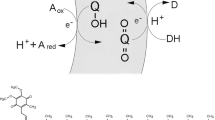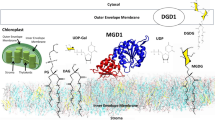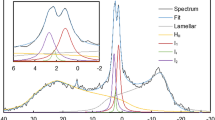Abstract
WE report here the observation of an ADP-dependent phosphorylation reaction in an artificial lipid vesicle system driven by pulsed ionising radiation. This reaction is completely dependent on the only enzyme incorporated into the phospholipid vesicle bilayer, the ATP synthetase (CF0–CF1) complex from spinach chloroplasts. Previous attempts to demonstrate directly an obligatory coupling between the proton pumping and phosphorylation activities of an ATP synthetase enzyme in resolved, reconstituted vesicle systems have required the presence of additional protein components1–3 to generate the transmembrane pH gradient and/or membrane potential postulated by the chemiosmotic hypothesis4 as the driving force for the ATP synthesis reaction: ADP+Pi+nH+in ⇌ ATP+H2O+nH+out Pulsed high-energy radiolysis of water produces, in a very brief time increment, significant quantities of protons along with the highly reactive transient species e−aq, OH, and H (δ[H+]∼ 10−5 M in 50 ns)5. Assuming a uniform production of protons throughout the aqueous media, differential buffering between the inner and outer aqueous compartments of phospholipid vesicles will result in the effectively instantaneous formation of a transmembrane proton gradient. We have applied the pulse radiolysis technique to drive the ATP synthetase activity of phospholipid vesicles reconstituted with the chloroplast CF0–CF1 enzyme complex.
This is a preview of subscription content, access via your institution
Access options
Subscribe to this journal
Receive 51 print issues and online access
$199.00 per year
only $3.90 per issue
Buy this article
- Purchase on Springer Link
- Instant access to full article PDF
Prices may be subject to local taxes which are calculated during checkout
Similar content being viewed by others
References
Ragan, I. C. & Racker, E. J. biol. Chem. 284, 2563–2569 (1973).
Racker, E. & Kandrach, A. J. biol. Chem. 248, 5841–5847 (1973).
Racker, E. & Stoeckenius, W. J. biol. Chem. 249, 662–663 (1974).
Mitchell, P. Biol. Rev. Cambridge Phil. Soc. 41, 445–502 (1966).
Matheson, M. S. & Dorfman, L. M. Pulse Radiolysis (MIT Press, Cambridge, Massachsetts, 1969).
Miller, C. & Racker, E. J. Membrane Biol. 26, 319–333 (1976).
Racker, E., Chien, T.-F. & Kandrach, A. FEBS Lett. 57, 14–18 (1975).
Winget, G. D., Kanner, N. & Racker, E. Biochim. biophys. Acta 460, 490–499 (1977).
Patterson, L. K. & Lilie, J. Int. J. Radiat. phys. Chem. 6, 129–141 (1974).
Ord, M. G. & Stocken, L. A. in Mechanisms in Radiobiology (eds Errera, M. & Forssberg, A.) 259–331 (Academic, New York, 1961).
Magnusson, R. P. & McCarty, R. E. J. biol Chem. 251, 6874–6877 (1976).
Gould, J. M., Cather, R. & Winget, G. D. Analyt. Biochem. 50, 540–548 (1972).
Roy, H. A. & Moudrianakis, E. N. Proc. natn. Acad. Sci. U.S.A. 68, 464–468 (1971).
Ort, D. R., Dilley, R. A. & Good, N. E. Biochim. biophys. Acta 449, 108–124 (1976).
Author information
Authors and Affiliations
Rights and permissions
About this article
Cite this article
GOULD, J., PATTERSON, L., LING, E. et al. Phosphorylation in a simple system of lipids and chloroplast ATP synthetase driven by pulsed ionising radiation. Nature 280, 607–609 (1979). https://doi.org/10.1038/280607a0
Received:
Accepted:
Published:
Issue Date:
DOI: https://doi.org/10.1038/280607a0
This article is cited by
-
Temperature oscillations near natural nuclear reactor cores and the potential for prebiotic oligomer synthesis
Origins of Life and Evolution of Biospheres (2016)
Comments
By submitting a comment you agree to abide by our Terms and Community Guidelines. If you find something abusive or that does not comply with our terms or guidelines please flag it as inappropriate.



